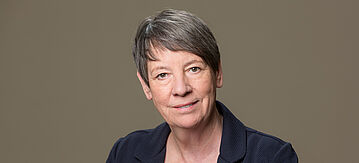Barbara Hendricks opens German Pavilion at the Biennale Architecture Exhibition in Venice
Federal Building Minister Barbara Hendricks opened the German pavilion at the 15th International Architecture Exhibition, la Biennale di Venezia, today. "This year’s motto, 'Reporting from the Front', makes it clear that the Biennale is in fighting spirit", Minister Hendricks commented. The participating countries are expected to showcase solutions that architects, planners, decision-makers and civil society players can provide to address the major social challenges of our time. Germany’s contribution "Making Heimat. Germany, Arrival Country" presents theses on successful integration, describes the prerequisites for lively and liveable urban neighbourhoods and highlights the contribution urban design and architecture can make in these areas.
Barbara Hendricks: "Not least because of the hundreds of thousands of refugees from the world’s war and crisis regions, Germany has been an arrival country these past months. It is a fact that Germany is a country of immigration, and we acknowledge this fact. The Making Heimat exhibition shows us how we can turn this fact into an opportunity. Arrival cities need affordable housing. It is important to achieve a good mix of residential and commercial uses by ensuring that shops and small businesses can be established on the ground floor of apartment buildings. The best schools should be located in the most problematic neighbourhoods. Arrival cities need a dense urban fabric and a good public transport system for those commuting to work."
The Federal Building Ministry (BMUB) commissioned the Deutsches Architekturmuseum (DAM) in Frankfurt to curate the German contribution, Making Heimat. The DAM team is led by director and general commissioner Peter Cachola Schmal, curator Oliver Elser and project coordinator Anna Scheuermann. Based on ideas developed by Canadian journalist Doug Saunders in his bestselling book "Arrival City" and his input as a consultant, the DAM has designed the pavilion to address questions like these: What are the challenges facing cities where refugees and migrants arrive? How can these new arrivals become fully integrated members of society? What contribution can architecture and urban design make in this process?
Minister Hendricks stated: "There are many elements to successful integration. One of them is quality, affordable housing for all. This means we need between 350,000 and 400,000 new flats per year, which is a rather ambitious goal. We should see this need as an opportunity for combining new housing concepts with lower per-capita land consumption, higher building density and good architectural quality."
In addition to the theses on successful integration presented and illustrated in the German pavilion, Making Heimat consists of two further parts. One is the website www.makingheimat.de, where the DAM presents practical examples of building projects for refugees and migrants. A database will allow users to compare popular solutions and will support local and regional decision-makers in their work. The examples are also an element of the exhibition. The third part is the design of the German pavilion itself. Through this design, the DAM has made the provisional character of arrival cities visible for all to see. The building structure of the pavilion has been opened up, disrespectfully breaking with existing structures while at the same time allowing for interaction with the outside world, the neighbours and the Venetian Lagoon. The pavilion was designed by the architectural firm ‘Something Fantastic’.
Building Minister Hendricks commented: "The Making Heimat exhibition incorporates all areas of society. This time we are not showing a traditional architectural contribution, which I applaud as the question of how we shape our living and social environment is closely linked with the question of how we shape our built environment."
The world’s most significant architectural exhibition is taking place in Venice from 27 May to 27 November 2016. The motto of the 2016 Biennale, "REPORTING FROM THE FRONT", was conceived by Chilean architect Alejandro Aravena, who is the director of this year’s show. Aravena is known for his commitment to social and affordable building and has been awarded the Pritzker Prize for his work.

